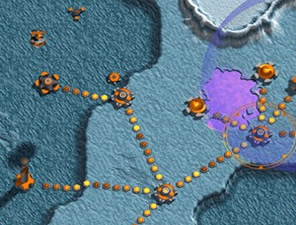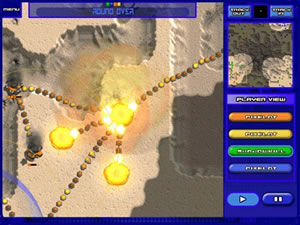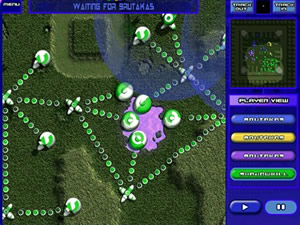Houston, we have an addiction.
Rumor has it that Moonbase Commander was never intended to be a game. That’s
not quite true. It was never intended to be a commercial game. Apparently,
it was the pet project of some programmers over at Humongous who were working
on another title for Infogrames. This game was just their little hobby. But they
kept playing it. And other people at the company started playing, too. And suddenly,
the LAN was full of people trying to rule the lunar surface.
Rather
than criticize people for not getting enough work done, the publisher decided
to just release the title upon the earthbound public just to see what would
happen. I have no idea if this is true, but it makes a nice story, and it might
explain some odd things about Moonbase Commander. More on that later.
Part Artillery, part Worms, part
chess, Moonbase Commander is a dorky, cute little game that won’t win
any awards and won’t make the ten o’ clock news. But its oddly addictive nature
might keep you up past ten, and eleven, and possibly even twelve, depending
on your bedtime.
Moonbase Commander puts you in remote control of a lunar module for
one of four mining companies, your very first “hub.” You must use your hub to
build other units, explore the moon’s surface, exploit energy pools, build offensive
and defensive stations, and blast anyone else you find into deep space.
The tricky part is in the way that you expand. From any of your hubs (which
you see from an overhead view), you can aim in a 360° circle. You then launch
your units from your hubs; the longer you hold the launch button, the further
they will travel, arcing over the lunar surface. They must land on flat ground
or they will crash and explode. On top of that, each structure trails an energy
line connecting it to its parent hub. These energy lines cannot cross or land
in water.
After your hubs, your most important structures are you anti-air stations.
Not only will they shoot down enemy weapons, but they will shoot down enemy
launches, preventing them from expanding too near you. Energy collectors are
also very important. Place them on energy pools to supply you with much needed
energy. Other structures include shields, offensive launchers, and towers. Everything
you build or fire requires energy, which makes securing sources of energy a
primary objective. The game is turn-based and like Worms, you only have
a certain amount of time to make your move. When you run out of energy, the
round is over.
 Attacking
Attacking
a well-defended enemy position is tricky, but you have lots of different weapons
at your disposal (although nowhere near as many as in Worms). They all
work the same way: aim carefully and launch. Bombs are the simplest and one
of the cheapest weapons. Just try to arc them to land on your opponent, Artillery
style. EMP bombs will knock out any units in their range for one turn, giving
you a valuable window of opportunity. Prowlers automatically crawl along the
surface in the direction they were launched until they hit something, causing
the biggest explosion in the game. Launch a Virus into your enemy’s system,
and it will roam along his energy lines wreaking havoc. However, all told, there
are only 18 total structures and weapons.
This is probably a good thing, because the instructions are sparse. The manual
does a poor job of explaining many things and there is no in-game tutorial.
There is, however, a “challenge mode” which starts very simply and provides
a series of increasingly harder maps and opponents. There’s also a quick skirmish
mode to play against some computer opponents, but there’s no campaign or story
anywhere in the game. The main game mode for Moonbase Commander is clearly
the multiplayer game. This is solid and seamless and obviously provides the
best challenge, but multiplayer matching must be done through Gamespy, which
isn’t always solid and seamless. Ugh.
It’s all these little things that makes me believe the story about the origins
of Moonbase Commander. The skimpy single player game, the lack of an
internal matchmaker, the clean but very simple graphics and the inability to
save your game make Moonbase Commander feel more like a hobby than a
commercial product.
That doesn’t mean it’s not fun, and like Tetris you can get sucked
into the simplest games for hours without realizing it. And Moonbase Commander‘s
$20 budget price tag does a lot to make up for its shortcomings. If you’re not
a hardcore gamer looking for the latest graphics and the biggest explosions,
or if you just have an older computer that can’t keep up with Battlefield
1942, you could do a lot worse than Moonbase Commander.

-
Simple, fun, addictive game
-
A good mix of strategy and artillery
-
Low system requirements
-
Maybe too simple
-
Feels thin
-
I can't save my game?











